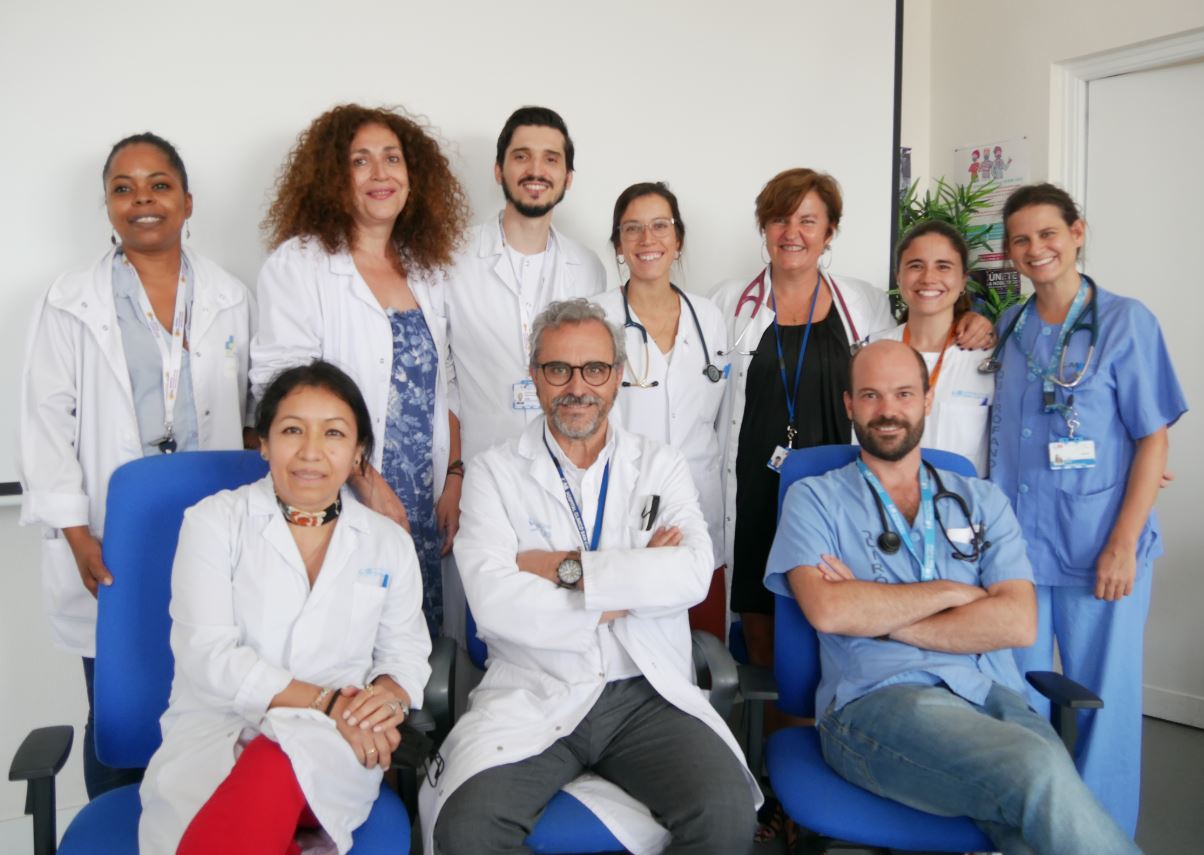
Tel. +34 913303000 (Ext. 483290)
Ground Floor, South Wing, Hospital Clínico San Carlos
C/ Profesor Martín Lagos s/n. 28040 Madrid

The Infectious Diseases/HIV/STI group is composed of the Infectious Diseases/HIV unit and the Sandoval Health Centre. The merger of the two units expands and complements the strategic objectives and related lines of research in the field of sexually transmitted infections (STIs).
The Infectious Diseases/HIV group has a long tradition of care at the Hospital Clínico; in 1987 the Isolation Unit was created under the auspices of Internal Medicine 3, Microbiology and Preventive Medicine, directed by the late Dr. Víctor Roca. Throughout this time, the group has differentiated itself from Internal Medicine and has focused on the field of infectious pathology, in three lines: HIV infection, viral hepatitis, and other infectious diseases. These three aspects of infectious pathology are the ones that have meant the greatest dedication to the group’s care. The HCSC’s HIV unit is one of the five largest in Madrid in terms of the number of patients under follow-up. As for the staff, Dr. Téllez and Dr. Estrada have been part of the group since its inception; in 2001 Dr. Vergas joined the group and since 2012, Dr. Núñez and Dr. Cabello are part of the group as well. For years, the unit has been staffed by personnel recruited from the FIBHCSC, currently nurses María Rodrigo and Eva Santiago, who are fully dedicated to research projects. Own projects have been carried out with the sponsorship of FIS (5 projects) and FIPSE (1 project); international HIV research projects are being carried out (Start, Partner, Sprit trials) and more than 50 clinical trials (CCT) have been conducted over the years, in particular phase III and IV trials. Own projects and clinical trials have been carried out in hepatitis C. In relation to other infectious diseases, the group has worked on international projects on influenza, tuberculosis, and phase 3 clinical trials on the treatment of pneumonia.
The Sandoval Health Centre, inaugurated in 1928, is the STI reference centre in Spain attached to the Hospital Clínico San Carlos since January 2018. It handles more than 32,000 consultations per year and performs more than 6,000 STI diagnoses per year. It is easily accessible and has on-demand care. It has high-resolution consultations in the diagnosis and treatment of HIV/STD/HCV, with intense research activity, collaborating in numerous studies. Four HIV/STI clinical trials are ongoing: HIV prevention and pre-exposure prophylaxis, treatment of gonorrhoea and diagnosis and prevention of HSV-2. It maintains a strong interaction with PC, Public Hospital Network and NGOs. It is the reference centre for the dispensing of PrEP pre-exposure prophylaxis in the Community of Madrid. Member of the AIDS Research Network (CoRIS), contributing the largest number of patients to the cohort.
Dr. Estrada studied Medicine at the Complutense University of Madrid and did his residency in Internal Medicine at the Hospital Clínico San Carlos. He completed his training in infectious diseases at the John Radcliffe Hospital in Oxford and at Chelsea and Westminster in London, England.
Since 1997 he has been working in HIV infection and is currently Head of the Infectious Diseases and HIV Unit at the Hospital San Carlos in Madrid. In the years of the pandemic his clinical and research activity has been redirected to Covid.
He is an advisor to the WHO on vaccines and treatment, and has participated in more than 25 clinical trials in this field.
Accredited as Full Professor of Medicine, currently Associate Professor of CCSS at the Complutense University; Associate Editor of BMC Infectious Diseases.
International External Advisor to the European Medicines Agency (EMA).
His main areas of interest are metabolic and cardiovascular risk associated with HIV infection, HIV transmission in serodiscordant couples and clinical aspects of Covid treatment. He is the author of some 190 publications in medical journals.
– Socio-demographic, clinical, and behavioural characteristics of new HIV diagnoses
– STI and HIV incidence of risk behaviours associated with chemsex
– Antiretroviral treatment in primary HIV infection
– Assessment of PrEP, safety, and efficacy of the combination of emtricitabine and tenofovir alafenamide (F/TAF) in HIV-exposed transgender men and women
– Molecular epidemiological surveillance study of HIV-1 infection
– HIV-2 and HTLV infection in Spain. Epidemiology and virological aspects
– Reproductive history and desire for procreation in women with HIV infection
– Epidemiology of Chlamydia trachomatis. Prevalence of Lymphogranuloma venereum
– New STI treatments
– Resistances to Mycoplasma genitalium and Neisseria gonorrhoeae
– Secondary prevention of anogenital cancer and follow-up of associated preneoplastic lesions
– Study of new HSV markers